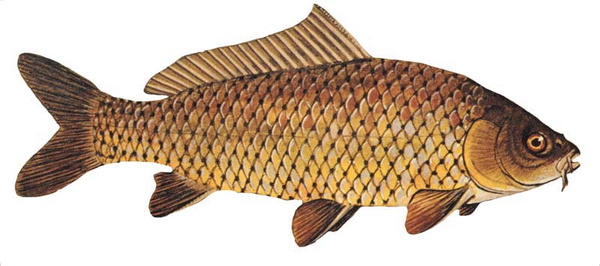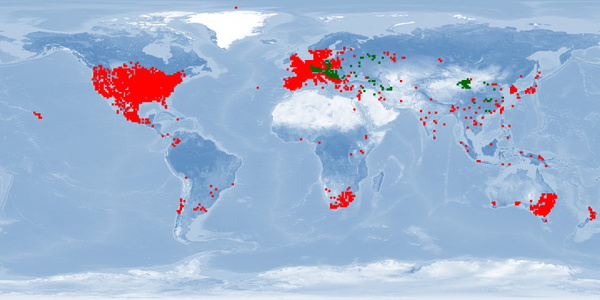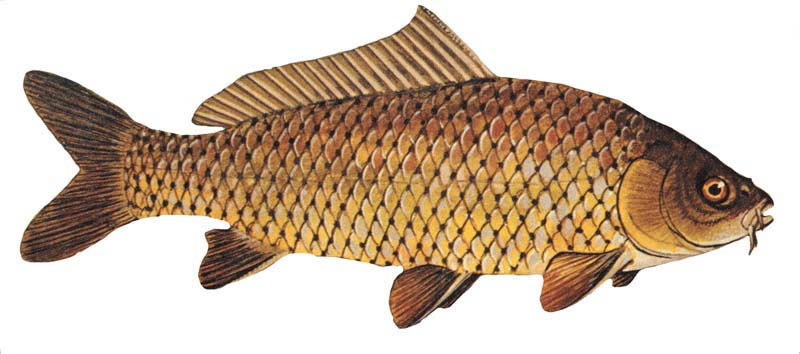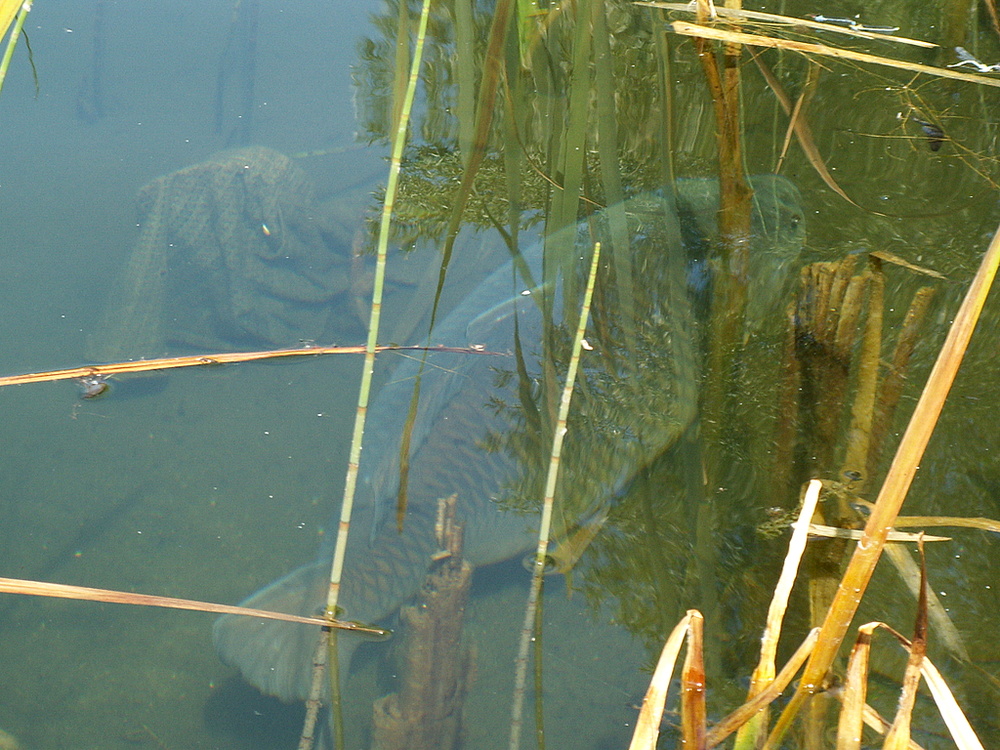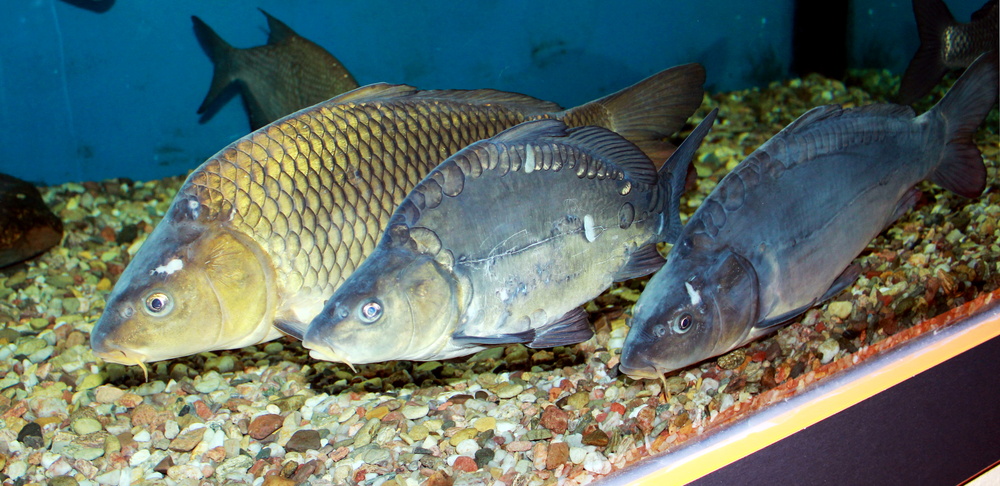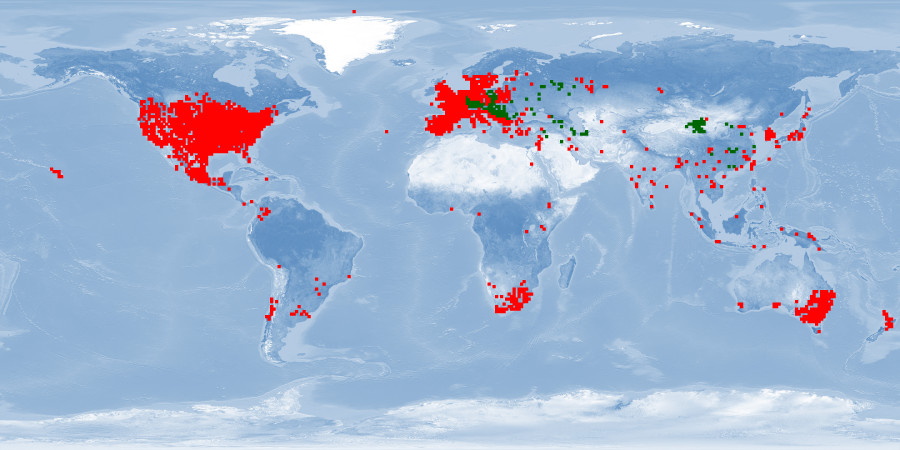Information
Version: C | 2.0 (2023-07-19)
- profile update resulting in major editorial and content changes (changing the scoring in criteria 1-3, 5-8)
- transfer to consistent age class and label structure resulting in changed appearance
WelfareScore | farm
Condensed assessment of the species' likelihood and potential for good fish welfare in aquaculture, based on ethological findings for 10 crucial criteria.
- Li = Likelihood that the individuals of the species experience good welfare under minimal farming conditions
- Po = Potential of the individuals of the species to experience good welfare under high-standard farming conditions
- Ce = Certainty of our findings in Likelihood and Potential
WelfareScore = Sum of criteria scoring "High" (max. 10)
General remarks
Cyprinus carpio is a widespread freshwater fish that is able to survive a wide range of water quality. It has been introduced into so many countries that it reached the status of a virtually global fish and is included in the list of the world's 100 worst invasive species. The native wild populations are considered vulnerable to extinction by the International Union for Conservation of Nature (IUCN). The hybridisation with the also invasive Carassius auratus probably increases its invasive potential due to enhanced genetic diversity. In aquaculture, the main production countries are located in Asia, such as China and Indonesia. It is commonly raised in EXTENSIVE or SEMI-INTENSIVE polycultures with Asian cyprinids, and its culture is fish meal independent, being mainly based on cereals. C. carpio is the oldest reared species, being the most commonly cultured and the third most significant fish species in the world production. However, there is still missing information for LARVAE, FRY, and SPAWNERS of this species about natural aggregation patterns, malformations, and home range, besides stress response and aggression under farming conditions. C. carpio is stressed by common farming procedures like transportation, crowding, and confinement. Moreover, as the demand for frozen or processed products is low, C. carpio is commonly sold in a fresh, live form on markets, thus probably slaughtered by asphyxia or hyporthermia, which is detrimental to its welfare.
1 Home range
Many species traverse in a limited horizontal space (even if just for a certain period of time per year); the home range may be described as a species' understanding of its environment (i.e., its cognitive map) for the most important resources it needs access to.
What is the probability of providing the species' whole home range in captivity?
It is low for minimal farming conditions. It is medium for high-standard farming conditions, as the range in captivity at least overlaps with the range in the wild. Our conclusion is based on a medium amount of evidence, as wild information in LARVAE, FRY, and SPAWNERS is missing.


2 Depth range
Given the availability of resources (food, shelter) or the need to avoid predators, species spend their time within a certain depth range.
What is the probability of providing the species' whole depth range in captivity?
It is low for minimal farming conditions, as some ponds do not cover the whole range in the wild. It is medium for high-standard farming conditions, as other ponds overlap with the range in the wild, although we cannot be sure in FRY and ADULTS. Our conclusion is based on a medium amount of evidence, as farm information for FRY and ADULTS has to be confirmed for C. carpio.


3 Migration
Some species undergo seasonal changes of environments for different purposes (feeding, spawning, etc.), and to move there, they migrate for more or less extensive distances.
What is the probability of providing farming conditions that are compatible with the migrating or habitat-changing behaviour of the species?
It is low for minimal farming conditions, as JUVENILES, ADULTS, and – in some populations – SPAWNERS undertake more or less extensive migrations, and we cannot be sure that providing each age class with their respective environmental conditions will satisfy their urge to migrate or whether they need to experience the transition. It is medium for high-standard farming conditions, as in some populations at least SPAWNERS do not migrate and the range in captivity potentially overlaps with the migration distance (although unknown). Our conclusion is based on a medium amount of evidence, as there is wild migration distance information missing in all age classes.


4 Reproduction
A species reproduces at a certain age, season, and sex ratio and possibly involving courtship rituals.
What is the probability of the species reproducing naturally in captivity without manipulation of theses circumstances?
It is low for minimal farming conditions, as the species is manipulated (separation by sex, hormonal manipulation, stripping). It is high for high-standard farming conditions, as natural breeding is possible and verified for the farming context. Our conclusion is based on a high amount of evidence.


5 Aggregation
Species differ in the way they co-exist with conspecifics or other species from being solitary to aggregating unstructured, casually roaming in shoals or closely coordinating in schools of varying densities.
What is the probability of providing farming conditions that are compatible with the aggregation behaviour of the species?
It is low for minimal farming conditions, as – even in the absence of density data in the wild – we may conclude from studies in farms or labs that densities in some ponds and RAS are potentially stress inducing. It is medium for high-standard farming conditions, as lower stress at stocking densities in other ponds and RAS is possible, but needs to be verified for the farming context. Our conclusion is based on a medium amount of evidence, as wild information is missing in almost all age classes.


6 Aggression
There is a range of adverse reactions in species, spanning from being relatively indifferent towards others to defending valuable resources (e.g., food, territory, mates) to actively attacking opponents.
What is the probability of the species being non-aggressive and non-territorial in captivity?
It is high for minimal and high-standard farming conditions, as there is no aggression (and for most cases also no competition) with a lot of species. Our conclusion is based on a low amount of evidence, as we are lacking studies specifically addressing aggression (or lack thereof).


7 Substrate
Depending on where in the water column the species lives, it differs in interacting with or relying on various substrates for feeding or covering purposes (e.g., plants, rocks and stones, sand and mud, turbidity).
What is the probability of providing the species' substrate and shelter needs in captivity?
It is low for minimal farming conditions, as the species uses substrate, but Zuger jars, holding jars, net pens, and RAS are devoid of it. It is high for high-standard farming conditions a) given hatching substrate for eggs and LARVAE as well as ponds for FRY, JUVENILES, and ADULTS and b) given natural reproduction in ponds for SPAWNERS in earthen ponds which are not replaced by concrete or stone bottom. Our conclusion is based on a high amount of evidence.


8 Stress
Farming involves subjecting the species to diverse procedures (e.g., handling, air exposure, short-term confinement, short-term crowding, transport), sudden parameter changes or repeated disturbances (e.g., husbandry, size-grading).
What is the probability of the species not being stressed?
It is low for minimal farming conditions. It is medium for high-standard farming conditions, as some of the many innovations to reduce stress need to be verified for the farming context. Our conclusion is based on a medium amount of evidence.


9 Malformations
Deformities that – in contrast to diseases – are commonly irreversible may indicate sub-optimal rearing conditions (e.g., mechanical stress during hatching and rearing, environmental factors unless mentioned in crit. 3, aquatic pollutants, nutritional deficiencies) or a general incompatibility of the species with being farmed.
What is the probability of the species being malformed rarely?
It is low for minimal farming conditions, as malformation rates exceed 10%. It is low for high-standard farming conditions, as malformations do not seem to result from conditions that may be changed (handling, heritability). Our conclusion is based on a low amount of evidence.


10 Slaughter
The cornerstone for a humane treatment is that slaughter a) immediately follows stunning (i.e., while the individual is unconscious), b) happens according to a clear and reproducible set of instructions verified under farming conditions, and c) avoids pain, suffering, and distress.
What is the probability of the species being slaughtered according to a humane slaughter protocol?
It is low for minimal farming conditions. It is high for high-standard farming conditions, as electrical plus percussive stunning, followed by evisceration, gill cut or destruction of the heart, induces unconsciousness fast, kills while still unconscious, and is verified for the farming context. Our conclusion is based on a medium amount of evidence, as more evidence is missing.


Side note: Domestication
Teletchea and Fontaine introduced 5 domestication levels illustrating how far species are from having their life cycle closed in captivity without wild input, how long they have been reared in captivity, and whether breeding programmes are in place.
What is the species’ domestication level?
DOMESTICATION LEVEL 5 99 100, fully domesticated. The first records of aquaculture are from China about 2,500 years ago 22 43.
Side note: Forage fish in the feed
450-1,000 milliard wild-caught fishes end up being processed into fish meal and fish oil each year which contributes to overfishing and represents enormous suffering. There is a broad range of feeding types within species reared in captivity.
To what degree may fish meal and fish oil based on forage fish be replaced by non-forage fishery components (e.g., poultry blood meal) or sustainable sources (e.g., soybean cake)?
All age classes:
- WILD: omnivorous 43 66 101. Non-native waters: detritivorous 16, omnivorous 16 21 15.
- FARM: traditional methods: SPAWNERS are fed with rice bran, kitchen refuse, corn, etc 4 (i.e., sustainable sources without fish meal).
- LAB: 5% soluble fish protein concentrate in feed of first-feeding FRY may be completely* replaced by sustainable sources 102. Fish meal may be partly* 103 104 105 to mostly* 105replaced by non-forage fishery components. Fish meal may be mostly* replaced by sustainable sources 106.
*partly = <51% – mostly = 51-99% – completely = 100%
Glossary
BENTHIC = living at the bottom of a body of water, able to rest on the floor
DOMESTICATION LEVEL 5 = selective breeding programmes are used focusing on specific goals 99
EXTENSIVE = low degree of intensification of fish farming in which no additional feed is provided to the fishes, and they solely rely on the natural feed produced in the system; often practised in traditional rice-fish cultures, cage and pen cultures in eutrophic waters, culture in lakes and reservoirs, etc. 1 2
FARM = setting in farming environment or under conditions simulating farming environment in terms of size of facility or number of individuals
FINGERLINGS = early juveniles with fully developed scales and working fins, the size of a human finger; for details ➝ Findings 10.1 Ontogentic development
FISHES = Using "fishes" instead of "fish" for more than one individual - whether of the same species or not - is inspired by Jonathan Balcombe who proposed this usage in his book "What a fish knows". By referring to a group as "fishes", we acknowledge the individuals with their personalities and needs instead of an anonymous mass of "fish".
FRY = larvae from external feeding on, for details ➝ Findings 10.1 Ontogenetic development
IND = individuals
JUVENILES = fully developed but immature individuals, for details ➝ Findings 10.1 Ontogenetic development
LAB = setting in laboratory environment
LARVAE = hatching to mouth opening, for details ➝ Findings 10.1 Ontogenetic development
PHOTOPERIOD = duration of daylight
POTAMODROMOUS = migrating within fresh water
RAS = Recirculating Aquaculture System - almost completely closed system using filters to clean and recirculate water with the aim of reducing water input and with the advantage of enabling close control of environmental parameters to maintain high water quality
SEMI-INTENSIVE = medium degree of intensification of fish farming in which additional feed is provided to the fishes through fertilisation and/or a small amount of additional feed; often practised in most integrated agriculture-aquaculture systems, some integrated peri-urban-aquaculture systems 1 2
SPAWNERS = adults during the spawning season; in farms: adults that are kept as broodstock
WILD = setting in the wild
Bibliography
2 Hambrey, J., P. Edwards, and B. Belton. 2008. An ecosystem approach to freshwater aquaculture: a global review. In FAO Fisheries and Aquaculture Proceedings, 14:117–121. Rome, Italy: FAO.
3 Balon, Eugene K. 1995. Origin and domestication of the wild carp, Cyprinus carpio: from Roman gourmets to the swimming flowers. Aquaculture 129. The Carp: 3–48. https://doi.org/10.1016/0044-8486(94)00227-F.
4 Jhingran, V.G., and R.S.V. Pullin. 1985. A hatchery manual for the common, Chinese and Indian major carps. Vol. 252. ICLARM Studies and Reviews 11. Asian Development Bank and International Center for Living Aquatic Resources Management.
5 Jeney, Z., and V. Bekh. 2020. Technical manual on broodstock management of common carp and Chinese herbivorous fish. Ankara, Turkey: Food and Agriculture Organization of the United Nations (FAO).
6 Horvath, L., G. Tamas, and C. Seagrave. 2002. Carp and Pond Fish Culture: Including Chinese Herbivorous Species, Pike, Tench, Zander, Wels Catfish, Goldfish, African Catfish and Sterlet. 2nd Edition.
7 Cordeli, A. N., L. Oprea, M. Crețu, and M. Mocanu. 2021. The influence of stocking densities on growth performance of common carp (cyprinus carpio, Linne 1758) reared in a recirculating aquaculture system. Scientific Papers. Series D. Animal Science 64: 509–516.
8 Økland, Finn, Clinton J. Hay, Tor F. Næsje, Eva B. Thorstad, and Nande Nickandor. 2001. Movements and habitat utilisation of radio tagged carp (Cyprinus carpio) in a reservoir in the Fish River, Namibia. NINA NAKU Project Report 013. Trondheim, Norway.
9 Crook, David A. 2004. Is the home range concept compatible with the movements of two species of lowland river fish? Journal of Animal Ecology 73: 353–366. https://doi.org/10.1111/j.0021-8790.2004.00802.x.
10 Enache, Ionica, Victor Cristea, Tudor Ionescu, and Sandita Ion. 2011. The influence of stocking density on the growth of common carp, Cyprinus carpio, in a recirculating aquaculture system. Aquaculture, Aquarium, Conservation & Legislation 4: 146–153.
11 Yengkokpam, S., D. Debnath, B. K. Bhattacharya, A. K. Yadav, P. Das, K. K. Sarma, and B. K. Das. 2019. Polyculture of Osteobrama belangeri with major carps in pen enclosures in Takmu lake of Manipur. Journal of the Inland Fisheries Society of India 51: 125–132. https://doi.org/10.47780/jifsi.51.2.2019.106697.
12 Bajer, Przemyslaw G., Hangkyo Lim, Mario J. Travaline, Brett D. Miller, and Peter W. Sorensen. 2010. Cognitive aspects of food searching behavior in free-ranging wild Common Carp. Environmental Biology of Fishes 88: 295–300. https://doi.org/10.1007/s10641-010-9643-8.
13 Richardson, R. E. 1913. Observations on the Breeding of the European Carp in the Vicinity of Havana, Illinois. Illinois Natural History Survey Bulletin 9: 384–405.
14 Flajšhans, M., and G. Hulata. 2017. Common Carp - Cyprinus carpio Biology, ecology and genetics. Genimpact final scientific report.
15 Watkinson, D. A., C. Charles, and E. C. Enders. 2021. Spatial ecology of common carp (Cyprinus carpio) in Lake Winnipeg and its potential for management actions. Journal of Great Lakes Research 47: 583–591. https://doi.org/10.1016/j.jglr.2021.03.004.
16 García-Berthou, Emili. 2001. Size- and depth-dependent variation in habitat and diet of the common carp (Cyprinus carpio). Aquatic Sciences 63: 466–476. https://doi.org/10.1007/s00027-001-8045-6.
17 Penne, Christopher R., and Clay L. Pierce. 2008. Seasonal Distribution, Aggregation, and Habitat Selection of Common Carp in Clear Lake, Iowa. Transactions of the American Fisheries Society 137: 1050–1062. https://doi.org/10.1577/T07-112.1.
18 Cooke, S. J., and R. S. McKinley. 1999. Winter residency and activity patterns of channel catfish, Ictalurus punctatus (Rafinesque), and common carp, Cyprinus carpio L., in a thermal discharge canal. Fisheries Management and Ecology 6: 515–526. https://doi.org/10.1046/j.1365-2400.1999.00175.x.
19 Dartay, M., T. Atessahİn, and E. Duman. 2017. Effects of water temperature and depth on the catch rate and catch per unit effort for mirror carp (Cyprinus carpio) caught by gillnets. Pakistan Journal of Zoology 49: 967–971. https://doi.org/10.17582/journal.pjz/2017.49.3.967.971.
20 Balon, Eugene K. 1995. The common carp, Cyprinus carpio: its wild origin, domestication in aquaculture, and selection as colored nishikigoi. Guelph Ichthyology Reviews 3.
21 Zhang, Y., Y. Li, L. Zhang, Z. Wu, S. Zhu, J. Li, and X. Li. 2020. Site Fidelity, Habitat Use, and Movement Patterns of the Common Carp during Its Breeding Season in the Pearl River as Determined by Acoustic Telemetry. Water 12: 2233. https://doi.org/10.3390/w12082233.
22 Rouhani, Qurban. 2010. Manual Rural Freshwater Aquaculture. Rural Fisheries Programme Department of Ichthyology and Fisheries Science.
23 Newbold, L. R., and P. S. Kemp. 2015. Influence of corrugated boundary hydrodynamics on the swimming performance and behaviour of juvenile common carp (Cyprinus carpio). Ecological Engineering 82: 112–120. https://doi.org/10.1016/j.ecoleng.2015.04.027.
24 Lechelt, J. D., M. J. Kocian, and P. G. Bajer. 2017. Low downstream dispersal of young-of-year common carp from marshes into lakes in the Upper Mississippi River region and its implications for integrated pest management strategies. Management of Biological Invasions 8: 485–495. https://doi.org/10.3391/mbi.2017.8.4.03.
25 Stott, N., and J. Miner. 2022. Environmental Cues of Spawning Migration into a Confined Wetland by Northern Pike and Common Carp in Lake Erie: Identifying Fine-Scale Patterns. North American Journal of Fisheries Management 42: 239–249. https://doi.org/10.1002/nafm.10742.
26 Alp, Ahmet, and Süleyman Balik. 2000. Growth Conditions and Stock Analysis of the Carp (Cyprinus carpio, Linnaeus 1758) Population in Gölhisar Lake. TURKISH JOURNAL OF ZOOLOGY 24: 291–304.
27 Sivakumaran, Kathiravelu P., Paul Brown, Daniel Stoessel, and Annie Giles. 2003. Maturation and Reproductive Biology of Female Wild Carp, Cyprinus carpio, in Victoria, Australia. Environmental Biology of Fishes 68: 321–332. https://doi.org/10.1023/A:1027381304091.
28 Karatas, Mehmet, Erdogan Cicek, Asiye Basusta, and Nuri Basusta. 2007. Age, Growth and Mortality of Common Carp (Cyprinus carpio Linneaus, 1758) Population in Almus Dam Lake (Tokat-Turkey). Journal of Applied Biological Sciences 1: 81–85.
29 Miller, S. A., and T. A. Crowl. 2006. Effects of common carp (Cyprinus carpio) on macrophytes and invertebrate communities in a shallow lake. Freshwater Biology 51: 85–94. https://doi.org/10.1111/j.1365-2427.2005.01477.x.
30 Tempero, Grant W., Nicholas Ling, Brendan J. Hicks, and Matthew W. Osborne. 2006. Age composition, growth, and reproduction of koi carp (Cyprinus carpio) in the lower Waikato region, New Zealand. New Zealand Journal of Marine and Freshwater Research 40: 571–583. https://doi.org/10.1080/00288330.2006.9517446.
31 Winker, Henning, Olaf L. F. Weyl, Anthony J. Booth, and Bruce R. Ellender. 2011. Life history and population dynamics of invasive common carp, Cyprinus carpio, within a large turbid African impoundment. Marine and Freshwater Research 62: 1270–1280. https://doi.org/10.1071/MF11054.
32 Hailu, Mathewos. 2013. Reproductive aspects of common carp (Cyprinus carpio L, 1758) in a tropical reservoir (Amerti, Ethiopia). Journal of Ecology and the Natural Environment 5: 260–264. https://doi.org/10.5897/JENE2013.0387.
33 Vilizzi, Lorenzo, and Keith F. Walker. 1999. Age and growth of the common carp, Cyprinus carpio, in the River Murray, Australia: validation, consistency of age interpretation, and growth models. Environmental Biology of Fishes 54: 77–106. https://doi.org/10.1023/A:1007485307308.
34 Hinojosa-Garro, Demián, and Luis Zambrano. 2004. Interactions of common carp (Cyprinus carpio) with benthic crayfish decapods in shallow ponds. Hydrobiologia 515: 115–122. https://doi.org/10.1023/B:HYDR.0000027323.77213.39.
35 Demirkalp, F. Yildiz. 2007. Growth Characteristics of Carp (Cyprinus carpio L., 1758) in Liman Lake (Samsun, Turkey). Hacettepe Journal of Biology and Chemistry 35: 1–8.
36 Demirkalp, F. Yildiz. 2007. Some of The Growth Characteristics of Carp (Cyprinus carpio L., 1758) in Çernek Lake (Samsun, Turkey). Hacettepe Journal of Biology and Chemistry 35: 57–65.
37 Coulter, David P., Jeffrey C. Jolley, Kris R. Edwards, and David W. Willis. 2008. Common carp (Cyprinus carpio) population characteristics and recruitment in two Nebraska sandhill lakes. Transactions of the Nebraska Academy of Sciences and Affiliated Societies 31: 35–41.
38 Haynes, G. D., J. Gongora, D. M. Gilligan, P. Grewe, C. Moran, and F. W. Nicholas. 2012. Cryptic hybridization and introgression between invasive Cyprinid species Cyprinus carpio and Carassius auratus in Australia: implications for invasive species management. Animal Conservation 15: 83–94. https://doi.org/10.1111/j.1469-1795.2011.00490.x.
39 Fernández-Delgado, Carlos. 1990. Life history patterns of the common carp, Cyprinus carpio, in the estuary of the Guadalquivir river in south-west Spain. Hydrobiologia 206: 19–28. https://doi.org/10.1007/BF00018966.
40 Reynolds, L.F. 1983. Migration Patterns of Five Fish Species in the Murray-Darling River System. Marine and Freshwater Research 34.
41 Johnsen, Peter B., and Arthur D. Hasler. 1977. Winter Aggregations of Carp (Cyprinus carpio) as Revealed by Ultrasonic Tracking. Transactions of the American Fisheries Society 106: 556–559. https://doi.org/10.1577/1548-8659(1977)106<556:WAOCCC>2.0.CO;2.
42 Rodriguez-Ruiz, A., and C. Granado-Lorencio. 1992. Spawning period and migration of three species of cyprinids in a stream with Mediterranean regimen (SW Spain). Journal of Fish Biology 41: 545–556. https://doi.org/10.1111/j.1095-8649.1992.tb02682.x.
43 Peteri, A. 2004. Cultured Aquatic Species Information Programme. Cyprinus carpio. Rome: FAO Fisheries and Aquaculture Department.
44 Hoda, S. M. Shamsul, and Hiroshi Tsukahara. 1971. Studies on the development and relative growth in the carp, Cyprinus carpio (Linné). Journal of the Faculty of Aquaculture, Kyushu University 16.
45 Kucharczyk, Dariusz, Katarzyna Targońska, Piotr Hliwa, Piotr Gomułka, Maciej Kwiatkowski, Sławomir Krejszeff, and Jacek Perkowski. 2008. Reproductive parameters of common carp (Cyprinus carpio L) spawners during natural season and out-of-season spawning. Reproductive Biology 8: 285–289. https://doi.org/10.1016/S1642-431X(12)60018-7.
46 Aliniya, Masoumeh, Hossein Khara, Shahrouz Baradaran Noveiri, and Hadiseh Dadras. 2013. Influence of Age of Common Carp (Cyprinus carpio) Broodstock on Reproductive Traits and Fertilization. Turkish Journal of Fisheries and Aquatic Sciences 13: 19–25.
47 Huang, Wen-Bin, Yu-Chun Lin, and Tai-Sheng Chiu. 2003. Effects of Stocking Density on Growth, Survival, Production, and Size Variation of the Common Carp Cyprinus carpio Linnaeus (1758) Fry within Aquariums. J. Fish. Soc. Taiwan 30: 29–41.
48 Bajer, P. G., C. J. Chizinski, and P. W. Sorensen. 2011. Using the Judas technique to locate and remove wintertime aggregations of invasive common carp. Fisheries Management and Ecology 18: 497–505. https://doi.org/10.1111/j.1365-2400.2011.00805.x.
49 Rahman, M. M., and C. G. Meyer. 2009. Effects of food type on diel behaviours of common carp Cyprinus carpio in simulated aquaculture pond conditions. Journal of Fish Biology 74: 2269–2278. https://doi.org/10.1111/j.1095-8649.2009.02236.x.
50 Taher, Majid M, and Adel Y Al-Dubakel. 2020. Growth Performance of Common Carp (Cyprinus carpio) in Earthen Ponds in Basrah Province, Iraq by Using Different Stocking Densities. Biological and Applied Environmental Research 4: 71–79.
51 Huntingford, G. Andrew, S. Mackenzie, D. Morera, S. M. Coyle, M. Pilarczyk, and S. Kadri. 2010. Coping strategies in a strongly schooling fish, the common carp Cyprinus carpio. Journal of Fish Biology 76: 1576–1591. https://doi.org/10.1111/j.1095-8649.2010.02582.x.
52 Papoutsoglou, S.E., H. Miliou, N.P. Karakatsouli, M. Tzitzinakis, and S. Chadio. 2001. Growth and physiological changes in scaled carp and blue tilapia under behavioral stress in mono- and polyculture rearing using a recirculated water system. Aquaculture International 9: 509–518. https://doi.org/10.1023/A:1020506814609.
53 Ruane, N M, E C Carballo, and J Komen. 2002. Increased stocking density influences the acute physiological stress response of common carp Cyprinus carpio (L.). Aquaculture Research 33: 777–784. https://doi.org/10.1046/j.1365-2109.2002.00717.x.
54 Ruane, Neil M, and Hans Komen. 2003. Measuring cortisol in the water as an indicator of stress caused by increased loading density in common carp (Cyprinus carpio). Aquaculture 218: 685–693. https://doi.org/10.1016/S0044-8486(02)00422-2.
55 Hoseini, S. M., B. Aydın, S. H. Hoseinifar, T. Moonmanee, and H. Van Doan. 2022. Dietary Artemisia, Artemisia annua, supplementation improves common carp welfare under high stocking density. Aquaculture Research 53: 3494–3503. https://doi.org/10.1111/are.15855.
56 Mesquita, Flavia Oliveira, Fabio Luiz Borcato, and Felicity Ann Huntingford. 2015. Cue-based and algorithmic learning in common carp: A possible link to stress coping style. Behavioural Processes 115: 25–29. https://doi.org/10.1016/j.beproc.2015.02.017.
57 Mizory, Firas A, Nizar J Hussein, Nareen S A Ali, and Salam R Hussein. 2020. Effect of Different Stocking Densities on Behavior of Common Carp (Cyprinus carpio) in Duhok Province, Kurdistan Region, Iraq. International Journal of Scientific Research in Biological Sciences 7: 1–6.
58 Horvath, L., G. Tamas, A.G. Coche, E. Kovács, T. Moth-Poulsen, and A. Woynarovich. 2015. Training manual on the artificial propagation of carps. A handout for on-farm training workshops on artificial propagation of common carp and Chinese major carps in Central and Eastern Europe, the Caucasus and Central Asia. 978-92-5-108689–6. Food and Agriculture Organization of the United Nations.
59 Azim, M. E., M. A. Wahab, A. H. M. Kamal, and Z. F. Ahmed. 2004. Feeding Relations of Silver Barb Barbodes gonionotus (Bleeker) with Major Indian and Common Carp and Its Effect on Fish Production in a Polyculture System. Journal of the World Aquaculture Society 35: 100–108.
60 Abdelghany, A. E., and M. H. Ahmad. 2002. Effects of feeding rates on growth and production of Nile tilapia, common carp and silver carp polycultured in fertilized ponds. Aquaculture Research 33: 415–423. https://doi.org/10.1046/j.1365-2109.2002.00689.x.
61 Nelson, Kirsten, David H. Wahl, and Greg G. Sass. 2014. Competitive interactions between common carp and bighead carp. In . Québec, Canada: Afs.
62 Rothuis, A J, C Q Nam, C J J Richter, and F Ollevier. 1998. Polyculture of silver barb, Puntius gonionotus (Bleeker), Nile tilapia, Oreochromis niloticus (L.), and common carp, Cyprinus carpio L., in Vietnamese ricefields: fish production parameters. Aquaculture Research 29: 661–668. https://doi.org/10.1046/j.1365-2109.1998.00256.x.
63 Rahman, Mustafizur M., Marc C. J. Verdegem, Leopold A. J. Nagelkerke, Mohammad A. Wahab, and Johan A. J. Verreth. 2008. Swimming, grazing and social behaviour of rohu Labeo rohita (Hamilton) and common carp Cyprinus carpio (L.) in tanks under fed and non-fed conditions. Applied Animal Behaviour Science 113: 255–264. https://doi.org/10.1016/j.applanim.2007.09.008.
64 Srithongthum, S., T. Amornsakun, P. Musikarun, P. Promkaew, A. H. Loong, G. Kawamura, M. T. M. Lal, and L.-S. Lim. 2020. Length-weight relationship and relative condition factor of the Sultan fish, Leptobarbus hoevenii broodstock farmed in earthen ponds. Egyptian Journal of Aquatic Biology and Fisheries 24: 53–59. https://doi.org/10.21608/ejabf.2020.91657.
65 Srithongthum, S., H.-L. Au, T. Amornsakun, P. Musikarun, W. J. Mok, N. F. A. Halid, G. Kawamura, and L. S. Lim. 2021. Reproductive Characteristics of the Pond-Farmed Sultan Fish (Leptobarbus hoevenii). Jurnal Ilmiah Perikanan dan Kelautan 13: 171–180. https://doi.org/10.20473/jipk.v13i2.27264.
66 Froese, R., and D. Pauly. 2017. Cyprinus carpio summary page. World Wide Web electronic publication. www.fishbase.org.
67 Balon, E. K. 1958. Vyvoj dunajského kapra (Cyprinus curpio curpio L.) v priebehu predlarvalnej fazy a larvalnej periody (Development of the Danubian carp during the prelarval and larval period). Biol. Pr. 4: 5–54.
68 Vilizzi, Lorenzo. 1998. Observations on ontogenetic shifts in the diet of 0+ carp, Cyprinus carpio, from the River Murray, Australia. Folia Zoologica 47: 225–229.
69 Parkos III, Joseph J, Jr. Santucci Victor J, and David H Wahl. 2003. Effects of adult common carp (Cyprinus carpio) on multiple trophic levels in shallow mesocosms. Canadian Journal of Fisheries and Aquatic Sciences 60: 182–192. https://doi.org/10.1139/f03-011.
70 Balon, Eugene K. 1975. Reproductive Guilds of Fishes: A Proposal and Definition. Journal of the Fisheries Research Board of Canada 32: 821–864. https://doi.org/10.1139/f75-110.
71 Balon, Eugene K. 1981. Additions and amendments to the classification of reproductive styles in fishes. Environmental Biology of Fishes 6: 377–389. https://doi.org/10.1007/BF00005769.
72 Balon, Eugene K. 1990. Epigenesis of an epigeneticist: the development of some alternative concepts on the early ontogeny and evolution of fishes. Guelph Ichthyology Reviews 1: 1–48.
73 Korwin-Kossakowski, M. 2008. The influence of temperature during the embryonic period on larval growth and development in carp, Cyprinus carpio L., and grass carp, Ctenopharyngodon idella (Val.): Theoretical and practical aspects. Archiwum Rybactwa Polskiego 16: 231–314.
74 Hoseinifar, Seyed Hossein, Narges Soleimani, and Einar Ringø. 2014. Effects of dietary fructo-oligosaccharide supplementation on the growth performance, haemato-immunological parameters, gut microbiota and stress resistance of common carp (Cyprinus carpio) fry. British Journal of Nutrition 112: 1296–1302. https://doi.org/10.1017/S0007114514002037.
75 Svobodová, Z., P. Kaláb, L. Dusek, B. Vykusová, Jitka KOLÁŘOVÁ, and D. Janousková. 1999. The Effect of Handling and Transport of the Concentration of Glucose and Cortisol in Blood Plasma of Common Carp. Acta Veterinaria Brno 68: 265–274.
76 Dobšíková, R., Z. Svobodová, J. Bláhová, H. Modrá, and J. Velíšek. 2006. Stress Response to Long Distance Transportation of Common Carp (Cyprinus carpio L.). Acta Veterinaria Brno 75: 437–448. https://doi.org/10.2754/avb200675030437.
77 Dobšíková, R., Z. Svobodová, J. Bláhová, H. Modrá, and J. Velíšek. 2009. The effect of transport on biochemical and haematological indices of common carp (Cyprinus carpio L.). Czech Journal of Animal Science 54: 510–518.
78 Taheri Mirghaed, Ali, and Melika Ghelichpour. 2019. Effects of anesthesia and salt treatment on stress responses, and immunological and hydromineral characteristics of common carp (Cyprinus carpio, Linnaeus, 1758) subjected to transportation. Aquaculture 501: 1–6. https://doi.org/10.1016/j.aquaculture.2018.11.008.
79 Hoseini, S. M., N. Majidiyan, A. T. Mirghaed, S. H. Hoseinifar, and H. Van Doan. 2022. Dietary glycine supplementation alleviates transportation-induced stress in common carp, Cyprinus carpio. Aquaculture 551: 737959. https://doi.org/10.1016/j.aquaculture.2022.737959.
80 Hoseini, S. M., S. K. Gupta, M. Yousefi, E. V. Kulikov, S. G. Drukovsky, A. K. Petrov, A. T. Mirghaed, S. H. Hoseinifar, and H. Van Doan. 2022. Mitigation of transportation stress in common carp, Cyprinus carpio, by dietary administration of turmeric. Aquaculture 546: 737380. https://doi.org/10.1016/j.aquaculture.2021.737380.
81 Mousavi, H.E., A.T. Mirghaed, S. M. Hoseini, M. Ghelichpour, A.A. Moghaddam, B. Gharavi, and B. Aydın. 2023. Myrcene as water conditioner, stress-reducing and antioxidant agent in transportation of common carp, Cyprinus carpio, with plastic bags. Aquaculture Reports 28: 101458. https://doi.org/10.1016/j.aqrep.2022.101458.
82 Ruane, N. M., E. A. Huisman, and J. Komen. 2001. Plasma cortisol and metabolite level profiles in two isogenic strains of common carp during confinement. Journal of Fish Biology 59: 1–12. https://doi.org/10.1111/j.1095-8649.2001.tb02334.x.
83 Ruane, N. M, E. A Huisman, and J Komen. 2002. The influence of feeding history on the acute stress response of common carp (Cyprinus carpio). Aquaculture 210: 245–257. https://doi.org/10.1016/S0044-8486(01)00819-5.
84 Yousefi, M., S. M. Hoseini, Y. A. Vatnikov, E. V. Kulikov, and S. G. Drukovsky. 2019. Rosemary leaf powder improved growth performance, immune and antioxidant parameters, and crowding stress responses in common carp (Cyprinus carpio) fingerlings. Aquaculture 505: 473–480. https://doi.org/10.1016/j.aquaculture.2019.02.070.
85 Varga, Dániel, András Szabó, Csaba Hanc, Zsigmond Jeney, László Ardó, Marcell Molnár, and Tamás Molnár. 2014. Impact of Handling and Pre-Mortal Stress on the Flesh Quality of Common Carp (Cyprinus carpio L.). The Israeli Journal of Aquaculture - Bamidgeh 66: 1–6.
86 Wysocki, Lidia Eva, John P. Dittami, and Friedrich Ladich. 2006. Ship noise and cortisol secretion in European freshwater fishes. Biological Conservation 128: 501–508. https://doi.org/10.1016/j.biocon.2005.10.020.
87 Kusku, Halit, Sebahattin Ergun, Sevdan Yilmaz, Betul Guroy, and Murat Yigit. 2018. Impacts of Urban Noise and Musical Stimuli on Growth Performance and Feed Utilization of Koi fish (Cyprinus carpio) in Recirculating Water Conditions. Turkish Journal of Fisheries and Aquatic Sciences 19: 513–523.
88 Reilly, Siobhan C., John P. Quinn, Andrew R. Cossins, and Lynne U. Sneddon. 2008. Behavioural analysis of a nociceptive event in fish: Comparisons between three species demonstrate specific responses. Applied Animal Behaviour Science 114: 248–259. https://doi.org/10.1016/j.applanim.2008.01.016.
89 Papoutsoglou, S. E, G Mylonakis, H Miliou, N. P Karakatsouli, and S Chadio. 2000. Effects of background color on growth performances and physiological responses of scaled carp (Cyprinus carpio L.) reared in a closed circulated system. Aquacultural Engineering 22: 309–318. https://doi.org/10.1016/S0144-8609(00)00056-X.
90 Ebrahimi, Ghaffar. 2011. Effects of Rearing Tank Background Color on Growth Performance in Juvenile Common Carp, Cyprinus carpio L. Agricultural Journal 6: 213–217.
91 Klaren, Peter H. M., Stephanie C. M. van Dalen, Wim Atsma, F. A. Tom Spanings, Jasper Hendriks, and Gert Flik. 2013. Voluntary timing of food intake increases weight gain and reduces basal plasma cortisol levels in common carp (Cyprinus carpio L.). Physiology & Behavior 122: 120–128. https://doi.org/10.1016/j.physbeh.2013.08.020.
92 GJURČEVIĆ, E., S. KUŽIR, Z. PETRINEC, D. STANIN, Z. MATAŠIN, and Z. KOZARIĆ. 2007. Incidence of vertebral column deformities in farmed and wild co mmon carp Cyprinus carpio reared under same conditions. In Proceedings of the World Aquaculture, 343–344. San Antonio, Texas.
93 Kužir, S., L. Maleničić, D. Stanin, T.T. Vukičević, I. Alić, and E. Gjurčević. 2015. Description of head deformities in cultured common carp (Cyprinus carpio Linnaeus, 1758). VETERINARSKI ARHIV 85: 437–449.
94 Al-Harbi, A.H. 2001. Skeletal Deformities in Cultured Common Carp Cyprinus carpio L. Asian Fisheries Science 14: 247–254.
95 European Food Safety Authority (EFSA). 2009. Species-specific welfare aspects of the main systems of stunning and killing of farmed Carp. EFSA Journal 1013: 1–37. https://doi.org/10.2903/j.efsa.2009.1013.
96 Rahmanifarah, K., B. Shabanpour, and A. Sattari. 2011. Effects of Clove Oil on Behavior and Flesh Quality of Common Carp (Cyprinus carpio L.) in Comparison with Pre-slaughter CO2 Stunning, Chilling and Asphyxia. Turkish Journal of Fisheries and Aquatic Sciences 11: 139–147.
97 Retter, Karina, Karl-Heinz Esser, Matthias Lüpke, John Hellmann, Dieter Steinhagen, and Verena Jung-Schroers. 2018. Stunning of common carp: Results from a field and a laboratory study. BMC Veterinary Research 14: 1–11. https://doi.org/10.1186/s12917-018-1530-0.
98 Daskalova, Aleksandra, Alexander Pavlov, Ralica Kyuchukova, and Hristo Daskalov. 2016. Humane Slaughter of Carp – A Comparison between Three Stunning Procedures. Turkish Journal of Fisheries and Aquatic Sciences 16: 753–758.
99 Teletchea, Fabrice, and Pascal Fontaine. 2012. Levels of domestication in fish: implications for the sustainable future of aquaculture. Fish and Fisheries 15: 181–195. https://doi.org/10.1111/faf.12006.
100 Teletchea, Fabrice. 2015. Domestication of Marine Fish Species: Update and Perspectives. Journal of Marine Science and Engineering 3: 1227–1243. https://doi.org/10.3390/jmse3041227.
101 Stergiou, K., D. C. Bobori, F. G. Ekmekçi, M. Gökoğlu, P. K. Karachle, G. Minos, Y. Özvarol, I. Salvarina, A. S. Tarkan, and L. Vilizzi. 2014. New Fisheries-related data from the Mediterranean Sea (April 2014). Mediterranean Marine Science 15: 213–224. https://doi.org/10.12681/mms.738.
102 Escaffre, Anne M., JoséL Zambonino Infante, Chantal L. Cahu, Muriel Mambrini, Pierre Bergot, and Sadasivam J. Kaushik. 1997. Nutritional value of soy protein concentrate for larvae of common carp (Cyprinus carpio) based on growth performance and digestive enzyme activities. Aquaculture 153: 63–80.
103 Hasan, M. R., D. J. Macintosh, and K. Jauncey. 1997. Evaluation of some plant ingredients as dietary protein sources for common carp (Cyprinus carpio L.) fry. Aquaculture 151. Fish Nutrition and Feeding Proceedings of the Sixth International Symposium on Feeding and Nutrition in Fish: 55–70. https://doi.org/10.1016/S0044-8486(96)01499-8.
104 Siddhuraju, P., and K. Becker. 2001. Preliminary nutritional evaluation of Mucuna seed meal (Mucuna pruriens var. utilis) in common carp (Cyprinus carpio L.): An assessment by growth performance and feed utilisation. Aquaculture 196: 105–123.
105 Mazurkiewicz, Jan. 2009. Utilization of domestic plant components in diets for common carp Cyprinus carpio L. Archives of Polish Fisheries 17: 5–39. https://doi.org/10.2478/v10086-009-0001-4.
106 Gao, Qi, Shu-kui Sun, Zhen Han, Jian-he Xu, Zhu-jin Ding, and Han-liang Cheng. 2020. Effects of partial replacement of fishmeal with blood meal and dried porcine soluble on the growth, body composition and intestinal morphology of Cyprinus carpio. Aquaculture Research 51: 1712–1719. https://doi.org/10.1111/are.14518.





